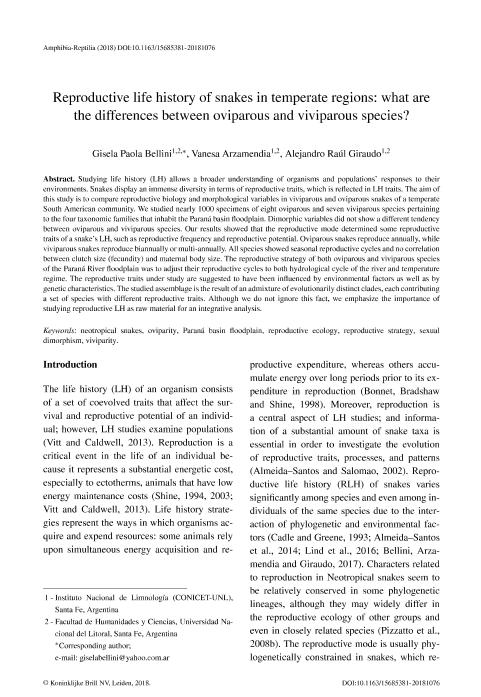Mostrar el registro sencillo del ítem
dc.contributor.author
Bellini, Gisela Paola

dc.contributor.author
Arzamendia, Vanesa

dc.contributor.author
Giraudo, Alejandro Raul

dc.date.available
2019-11-11T18:22:34Z
dc.date.issued
2018-11
dc.identifier.citation
Bellini, Gisela Paola; Arzamendia, Vanesa; Giraudo, Alejandro Raul; Reproductive life history of snakes in temperate regions: What are the differences between oviparous and viviparous species?; Brill Academic Publishers; Amphibia-Reptilia; 40; 3; 11-2018; 291-303
dc.identifier.issn
0173-5373
dc.identifier.uri
http://hdl.handle.net/11336/88503
dc.description.abstract
Studying life history (LH) allows a broader understanding of organisms and populations? responses to theirenvironments. Snakes display an immense diversity in terms of reproductive traits, which is reflected in LH traits. The aim ofthis study is to compare reproductive biology and morphological variables in viviparous and oviparous snakes of a temperateSouth American community. We studied nearly 1000 specimens of eight oviparous and seven viviparous species pertainingto the four taxonomic families that inhabit the Paraná basin floodplain. Dimorphic variables did not show a different tendencybetween oviparous and viviparous species. Our results showed that the reproductive mode determined some reproductivetraits of a snake?s LH, such as reproductive frequency and reproductive potential. Oviparous snakes reproduce annually, whileviviparous snakes reproduce biannually or multi-annually. All species showed seasonal reproductive cycles and no correlationbetween clutch size (fecundity) and maternal body size. The reproductive strategy of both oviparous and viviparous speciesof the Paraná River floodplain was to adjust their reproductive cycles to both hydrological cycle of the river and temperatureregime. The reproductive traits under study are suggested to have been influenced by environmental factors as well as bygenetic characteristics. The studied assemblage is the result of an admixture of evolutionarily distinct clades, each contributinga set of species with different reproductive traits. Although we do not ignore this fact, we emphasize the importance ofstudying reproductive LH as raw material for an integrative analysis.
dc.format
application/pdf
dc.language.iso
eng
dc.publisher
Brill Academic Publishers

dc.rights
info:eu-repo/semantics/openAccess
dc.rights.uri
https://creativecommons.org/licenses/by-nc-sa/2.5/ar/
dc.subject
NEOTROPICAL SNAKES
dc.subject
OVIPARITY
dc.subject
PARANA BASIN FLOODPLAIN
dc.subject
REPRODUCTIVE ECOLOGY
dc.subject.classification
Ecología

dc.subject.classification
Ciencias Biológicas

dc.subject.classification
CIENCIAS NATURALES Y EXACTAS

dc.title
Reproductive life history of snakes in temperate regions: What are the differences between oviparous and viviparous species?
dc.type
info:eu-repo/semantics/article
dc.type
info:ar-repo/semantics/artículo
dc.type
info:eu-repo/semantics/publishedVersion
dc.date.updated
2019-10-25T18:52:21Z
dc.journal.volume
40
dc.journal.number
3
dc.journal.pagination
291-303
dc.journal.pais
Países Bajos

dc.journal.ciudad
Leiden
dc.description.fil
Fil: Bellini, Gisela Paola. Consejo Nacional de Investigaciones Científicas y Técnicas. Centro Científico Tecnológico Conicet - Santa Fe. Instituto Nacional de Limnología. Universidad Nacional del Litoral. Instituto Nacional de Limnología; Argentina
dc.description.fil
Fil: Arzamendia, Vanesa. Consejo Nacional de Investigaciones Científicas y Técnicas. Centro Científico Tecnológico Conicet - Santa Fe. Instituto Nacional de Limnología. Universidad Nacional del Litoral. Instituto Nacional de Limnología; Argentina
dc.description.fil
Fil: Giraudo, Alejandro Raul. Consejo Nacional de Investigaciones Científicas y Técnicas. Centro Científico Tecnológico Conicet - Santa Fe. Instituto Nacional de Limnología. Universidad Nacional del Litoral. Instituto Nacional de Limnología; Argentina
dc.journal.title
Amphibia-Reptilia

dc.relation.alternativeid
info:eu-repo/semantics/altIdentifier/doi/http://dx.doi.org/10.1163/15685381-20181076
Archivos asociados
